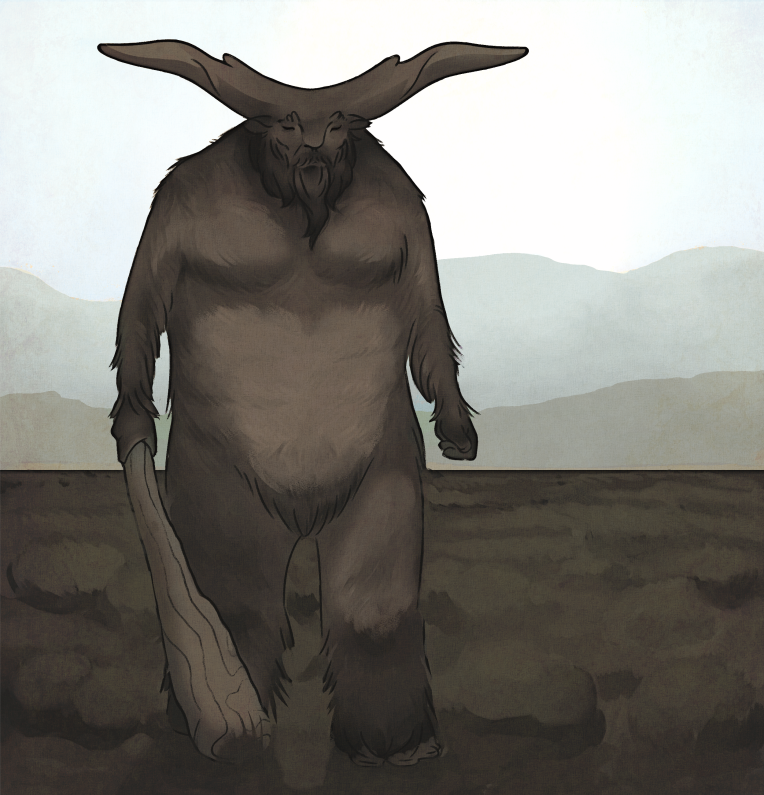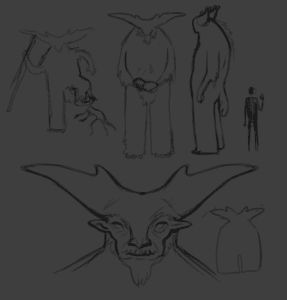
The Oong are an herbivorous race of giants native to the Rachi Steppes. Their origin is a result of selective pressure, being derived from human descendants who evolved herd mentality and grew larger due to being preyed upon by the Weria.
As their main foes commonly change appearance, and the Oong, by nature, tend to be hypersensitive to threats, they refer to keep to themselves and rarely make contact with outsiders.
A slow metabolism and low birth rate keep their population small, but their territory is pretty large due to their migratory patterns. Each family is controlled by the eldest married pair while migrating. During the winters when they settle down, they switch to an elected married pair.
Culture
The Oong have no concept of political territory. To them, the Rachi Steppes and surrounding areas are not owned or claimed, but rather a shared and ever-changing landscape that sustains their nomadic way of life.
Their flags and banners, thus mostly serve as a kind of family portrait. Their artwork tends towards simplicity and crudeness, made using local dyes and rough fabric. A new flag will be made after marriage, and handprints will be added after the birth or adoption of a new member. Adult males make up the base, then adult females, then children, symbolizing their familial structure. The more handprints, the stronger the family.
The Oong also share a deep spiritual connection to nature, which serves as the foundation of their religious beliefs and cultural practices. They revere the vast and ever-changing landscape of the Rachi Steppes as a manifestation of a higher power, often referred to as “The Great Harmony.” To the Oong, this spiritual force embodies the balance and interdependence that governs all living beings and the natural world.
Society
Unity and strength in numbers are among the core values of Oong society. This is reflected in the size of their tribes, which, upon the move, resemble a large army in their own right. This, coupled with the harsh wilderness the Oong call home, is also why other cultures have been unable to subdue the region so far.

Oong migrate seasonally. During the winters when Weria are at their peak, they congregate at a single, fortified location. Winter is a time of relaxation, seeing distant family, and marriage. During their congregation, the Oong may also gather in a grand ceremony to pay homage to The Great Harmony, expressing gratitude for protection during the harsh months and seeking blessings for the upcoming migrations.
As temperatures warm and the Weria threat dies down, Oong begin to take their first steps onto the steppes. Those too old or weak to make the journey will stay at the fortress, repairing and maintaining the architecture. The young families make their way around and across, dispersing from every direction and carrying only what they need. Newlyweds will split from their families for the first time and make the journey alone during this period.
During migration, Oong gather food, have offspring, and make art, which usually manifests as stone-stacking or crude paintings. A traveler would easily know when they’re in Oong territory because of the hundreds of stacked rock piles that commonly reach up to 15 feet. These stacks are used to mark migration paths, graves, sacred sites, or simply for entertainment.
Although usually on the move, spring homes do crop up for a few weeks at a time. These homes consist of a circular hole in the ground covered by a large tarp held up by a pole in the center. These homes tend to be crude because they’re meant as only temporary settlements.
The winter home, on the other hand, is meant to be permanent and so tends towards being a bit more complex. The basic structure is the same, a big hole in the ground, but the excess dirt is used to build a massive wall around the complex. Nothing too sophisticated, but a pretty remarkable level of teamwork for a species that’s not terribly intelligent. Individual families have their own houses within the walls where they store personal belongings and food for their elders who stay there year-round.
This entry was made by community member, Tid Fricker